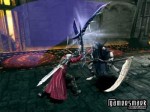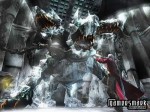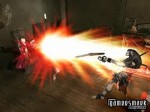Developer: Triumph Studios | Publisher: Codemasters || Overall: 8.5/10
It’s not too often you get to be the bad guy in a game. In Overlord: Raising Hell, you’re given the primary role of being “The Overlord” – the master of the Minions. With their help, you’ll rebuild your evil kingdom, confronting those that have killed your predecessor and rebuilding your once-fear-inducing-yet-humble abode. Throughout the levels you’ll find pieces of your tower, power-ups, and more minions to help you.
Essentially, Overlord is a mish-mash of a few genres – action, RPG, and real-time-strategy. The action influences come from the obvious gameplay mechanics such as controlling a menacing dude who goes around beating people with his axe, solving puzzles, and the like. The RPG elements come in with increasing your stats by gaining new weapons and getting new power-ups to help you maintain those stats. The most interesting aspect of Overlord, however, is how it accomplishes being real-time-strategy in tandem with the aforementioned aspects of gameplay.
Fundamentally, the importance of succeeding in Overlord is using your Minions in a strategic fashion to accomplish goals. Sure, you could go in and swing your weapon around at your enemies, but that would take a long time — not to mention there are some very difficult enemies where taking them on alone would be nigh impossible. Thinking of Minions as your “units” in a real-time-strategy game, you send them into battle and watch the mayhem unfold, modifying their focus as needed. While it starts simple, more strategy is involved when certain enemies are susceptible only to certain types of Minions’ attacks.
There are four different types of Minions – Browns, Reds, Greens, and Blues. The Browns are multipurpose melee fighters; Reds are long-range, fire-based attackers; Greens are stealthy, poisonous melee fighters that are weaker than your Browns; Blues are weak but they swim in water and can resurrect other Minions. Using all the different Minions and their unique skills to your advantage is the real challenge of Overlord.
The control scheme is something to be appraised. While you don’t normally see RTS-type games on consoles, Overlord has an advantage from being in a 3rd-person perspective. If you just want to tell your Minions to go somewhere, you move the right stick and control your group to go wherever you want without moving The Overlord himself. The camera also follows your group of Minions without getting far away from The Overlord, just in case something starts attacking you, but it also keeps the focus of the game of you being The Overlord at the same time. This comes into use when you meet obstacles that only Minions can go through, and you must use them appropriately to solve the puzzle or defeat the enemies at hand. If you just want to send your minions in to destroy anything they see in front of you, you just press and hold the R2 button and you’ll be able to watch the carnage, get the rewards, and not have to get your own hands dirty at all.
While the graphics aren’t the most beautiful you’ve ever seen, there is a style to the game that makes it feel like if it were any different, a certain charm about the game would be lost. The visuals match Overlord’s zany humor, with all the different quests you’ll be going on and different things your Minions will say. In a sense, it’s almost like playing a cartoon. Your Minions say some clever/funny things at times like “Treasssurreeeee!,” or “For the master!,” or “For the Overlorrrrrd!” while they bring treasure and other items back to you. There are also some offhand Minion comments that are context-specific.
While visiting your Tower, a Jester will follow you around calling you different things based on the quests you have already accomplished. My personal favorite is “Persecutor of Pumpkins” — referencing a quest in which you kill evil pumpkins that are eating townspeople. While that may sound off, considering that you’re supposed to be evil, the way the game rationalizes doing any good for people in the first place is that if they’re all dead, there’d be no one to boss around and torture. However, you are given the option of killing any of your subjects at any point, which raises a stat called “Corruption.” A certain amount of Corruption allows you to gain more power and skills, but must be taken in moderation, as there are disadvantages to gaining Corruption percentage.
Overlord: Raising Hell for the PS3 includes the DLC that was available for download on Xbox 360 and PC. The DLC adds a good 10 or 15 hours of playtime on the 20 hours or so the normal game had previously. There are also some other improvements and additions to the game that are integrated, along with the extra levels compared to the initial release of Overlord.
Probably the only things that I can complain about is the loading and other small technical issues that make the game a bit cumbersome to play at times. Loading usually takes a bit longer than I would hope for, especially since there’s about a minute of loading as soon as you start up the game as well as loading whenever you enter a new level. I encountered a few bugs that would result in the game becoming broken, forcing me to either load the game from my last autosave or restart my PS3. The minimap is almost a pain to use: while it is definitely a needed and welcomed addition from the normal version of the game, it can be hard to find your quests sometimes since you can’t really zoom out on it. There is a full-size map, but it’s not nearly as useful as the minimap.
Multiplayer is also a huge disappointment on the PS3. There is no one to play with online, so that means you can’t even use the multiplayer mode. This severely diminishes the value of the game if you had ever intended on checking out the multiplayer portion. However, since I’m a big proponent of single player games, it’s not a huge dent to my overall opinion about the game, though it is still something to take into account when purchasing it. It is also worth mentioning that seven multiplayer maps are part of the additions to the game from the first edition. Even though on the box it says you can play multiplayer in split-screen, I couldn’t find the option to do so in the menu.
Overlord: Raising Hell is a fun title, especially if you can pick it up for cheap. Overlord: Raising Hell offers a unique combination of several genres that creates an enjoyable and humorous addition to any PS3 owner’s library.





